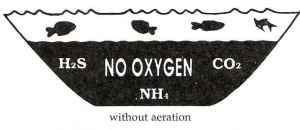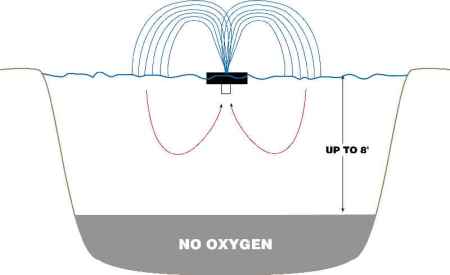The most important factor in ensuring the success of a large pond or
lake is proper
aeration. Dissolved oxygen is a critical
component in the ecology of a pond. It is what makes the pond
go and what keeps the inhabitants healthy and keeps the water clean.
This article will discuss the consequences of poor aeration and low
dissolved oxygen levels and the numerous benefits of proper
pond
aeration and healthy dissolved oxygen levels.
To be technical, dissolved oxygen is gaseous oxygen dissolved
in an aqueous solution. So basically it is the amount of oxygen
available in the pond water. Generally speaking 5 ppm is the
baseline for what is good for a pond or lake. Anything below
that can lead to problems.
So what are these problems associated with low dissolved
oxygen and what causes them? The most critical problem associated with
low oxygen levels is a fish kill. Fish require a certain ppm
of dissolved oxygen to live and without it…well, they
die. Poor oxygen levels can also lead to noxious odors coming
from the pond as the break down of organic waste will shift from an
aerobic process to a slower anaerobic process that results in the
production of hydrogen sulfide. Also, in the case of deeper ponds, the
lack of oxygen will lead to stratification meaning there becomes a
layer at the bottom of the pond that becomes un-usable as it is
extremely oxygen deficient. This in turn reduces the
available living space of the fish, placing more strain on the still
oxygenated water
The issues that cause oxygen levels to become low are
numerous. Probably the most common is an over abundance of
aquatic plants, particularly algae. Aquatic plants are good in
moderation as they do release oxygen into the water. In the
case of algae, planktonic algae make up the base of the food chain in a
pond and are therefore critical. However, many of these
plants that release oxygen during the day, also consume oxygen at
night. So when you have a pond with a heavy algal bloom or
thick aquatic vegetation, oxygen can be rapidly consumed overnight and
even on cloudy days, causing a fish kill.
Other factors that contribute to poor dissolved oxygen levels
and the need for
pond aeration is a high organic waste load.
Organic waste in a pond can come from a variety of sources including
dead vegetation, fertilizer run-off, fish food and fish
waste. All of those examples are naturally broken down in a
pond, but to do so efficiently and without further detriment to the
water quality, oxygen is needed. So when you have a high
waste load to be degraded, you will require a large amount of oxygen to
do so.
So, by now you may be concerned that these issues could
affect your pond and you want to prevent them from happening, but are
not sure how to select
pond aeration system.
True, there are varying types of pond aerators to choose from, but to
keep things simple, you basically have two types of aeration systems:
surface aeration and bottom based aeration. A good rule of
thumb for figuring out which one would be best is to use the average
depth of your pond as a barometer. If your pond is less than
6 feet deep, than a surface aeration system will probably work well,
while deeper ponds will benefit more from a bottom based aeration
system.
What is the difference between the two you may be
wondering.
Surface aerators are generally
floating aeration
units that pull in water from the top foot or so of the pond and splash
it into the air. As the water crashes back down onto the
pond, oxygen transfer takes place as well as the venting of gases.
Because the oxygen transfer is taking place just at the surface,
these
aeration systems or best suited for shallower ponds.
Surface aerationunits can also be equipped with different spray patterns for more
aesthetic appeal, however the more extravagant the spray, usually the
less efficient it is at aerating.
Bottom based aeration systems or diffused aeration involves
pushing air down to the bottom of a pond or lake and allowing the
bubbles to naturally rise to the surface.
These aeration
units are the most efficient for aerating deeper pond and lakes as the
bubbles are providing the bulk of the work. As the bubbles
rise, they destratify the water eliminating the oxygen poor zone at the
bottom and mixing it with the oxygen rich water above creating a
healthier water column.
These systems also create very little surface
agitation other than a gentle rolling action therefore providing no
aesthetic appeal.
It is important to note that unless you have a very round
even depth pond, you should look for
assistance in sizing a proper
aeration unit to meet the needs of your pond. Having an
undersized
aeration system can actually lead to problems instead of
helping them.
Now you have a properly sized
pond aeration system.
What can you expect now? The benefits to expect from a good
aeration systems are numerous.
- Fish kills(due to
low oxygen) can be prevented
- Beneficial pond bacteria is
stimulated to efficiently break down waste and reduce the bottom muck
layer. Aerobic bacteria will out proliferate problematic
anaerobic bacteria to control odors
- Key nutrients such as
phosphates are rendered unavailable and metals like iron are
precipitated out
- Algae blooms will
be less severe and less problematic due to the lack of available
nutrients
- Pond water is
destratified leading to the prevention of turnovers and improved
overall water quality
- Gasses such as
carbon dioxide and hydrogen sulfide can be vented
- The need for
maintenance products are reduced to the ponds naturally ability to
regulate itself.
- In the case of
northern states, aeration systems will also help prevent winter fish
kills be preventing the pond’s surface from freezing over and
allowing the venting of gasses.
Pond aeration systems can be a significant financial
investment, depending upon the size of the pond being
aerated. However the costs associated with monthly water
treatments, regular maintenance and the constant worrying about the
quality of water are far greater than the long term benefits and peace
of mind associated with a
good aeration system.




